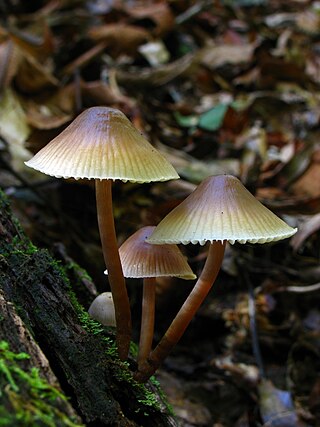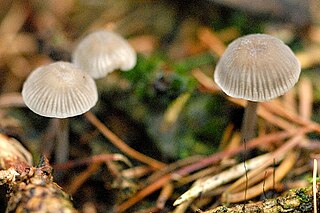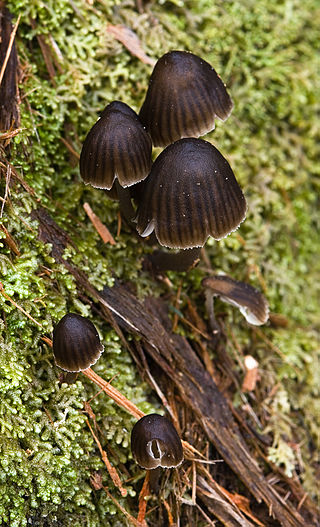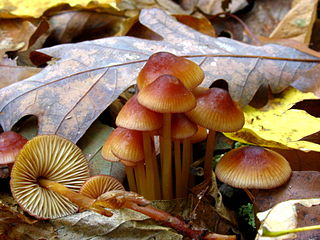
Mycena galericulata is a mushroom species commonly known as the common bonnet, the toque mycena, the common mycena or the rosy-gill fairy helmet. The type species of the genus Mycena was first described scientifically in 1772, but was not considered a Mycena until 1821. It is quite variable in color, size, and shape, which makes it somewhat difficult to reliably identify in the field. The mushrooms have caps with distinct radial grooves, particularly at the margin. The cap's color varies from grayish brown to dark brown and the shape ranges from bell-like to bluntly conical to flattened with an umbo. The stem is hollow, white, tough and thin, without a ring and often roots deeply into the wood on which it grows. The gills are white to grayish or even pinkish when mature and are connected by distinct cross-veins. The caps can reach 4 cm (1.6 in) in diameter, and have a mealy odor and taste. The spore print is white and the gills are pink at maturity, which can lead to possible confusion with species of the genus Pluteus. M. galericulata mushrooms grow mostly in clusters on the well-decayed stumps of deciduous and coniferous trees from spring to autumn. The species can generally be considered inedible. It is common and widespread in the entire temperate zone of the Northern Hemisphere, but it has also been reported from Africa.

Mycena adscendens, commonly known as the frosty bonnet, is a species of fungus in the family Mycenaceae. The fungus produces small white fruit bodies (mushrooms) with caps up to 7.5 mm (0.3 in) in diameter that appear to be dusted with sugar-like granules. Caps are supported by thin, hollow stems up to 20 mm (0.8 in) long, which are set on a disc-like base. Its distribution includes Europe, Turkey and the Pacific coast of the United States. The fruit bodies grow on fallen twigs and other woody debris on the forest floor, including fallen hazel nuts. The variety carpophila is known from Japan. There are several small white Mycena species that are similar in appearance to M. adscendens, some of which can be reliably distinguished only by examining microscopic characteristics.

Mycena cinerella, commonly known as the mealy bonnet, is an inedible species of mushroom in the family Mycenaceae. It is found in Europe and the United States, where it grows in groups on fallen leaves and needles under pine and Douglas fir. The small grayish mushrooms have caps that are up to 1.5 cm (0.6 in) wide atop stipes that are 5 cm (2.0 in) long and 2.5 mm (0.10 in) thick. Its gills are grayish-white and adnate, with a "tooth" that runs slightly down the stipe. The fungus has both two- and four-spored basidia. As its common name suggests, it smells mealy.

Mycena nargan, commonly known as the Nargan's bonnet, is a species of fungus in the family Mycenaceae, and the sole member of the section Nargan in the genus Mycena. Reported as a new species in 1995, it is known predominantly from Southern Australia. The saprobic fungus produces mushrooms that grow on well-decayed wood, often on the underside of wood lying in litter. The dark chestnut-coloured caps are covered with white, easily removed scales, and reach diameters of up to 2 cm (0.8 in) wide. The pale, slender stems are up to 5 cm (2.0 in) long and have white scales at the base. On the underside of the cap, the cream-coloured gills are widely spaced and bluntly attached to the stem. The edibility of the mushroom is unknown.

Hydnellum ferrugineum, commonly known as the mealy tooth or the reddish-brown corky spine fungus, is a species of tooth fungus in the family Bankeraceae. A widely distributed species, it is found in north Africa, Asia, Europe, and North America. The fungus fruits on the ground singly or in clusters in conifer forest, usually in poor or sandy soil. Fruit bodies are somewhat top-shaped, measuring 3–10 cm (1–4 in) in diameter. Their velvety surfaces, initially white to pink, sometimes exude drops of red liquid. The lower surface of the fruit body features white to reddish-brown spines up to 6 mm long. Mature fruit bodies become dark reddish brown in color, and are then difficult to distinguish from other similar Hydnellum species. H. ferrugineum forms a mat of mycelia in the humus and upper soil where it grows. The presence of the fungus changes the characteristics of the soil, making it more podzolized.

Mycena clariviolacea is a mushroom in the family Mycenaceae. First reported as a new species in 2007, it is known only from Kanagawa, Japan, where it fruits on dead fallen twigs in forests dominated by oak and chinquapin trees. Distinctive features of this species are found in its medium-sized, dark violet fruit bodies, with caps up to 25 mm (0.98 in) in diameter and slender stems that are about 30 to 40 mm long. Microscopic characteristics include the amyloid spores, the club-shaped cheilocystidia that are covered with one or more, knob-like, apical protuberances, the absence of pleurocystidia, and the cylindrical, diverticulate caulocystidia.

Mycena fonticola is a species of fungus in the family Mycenaceae. First reported in 2007, it is known only from central Honshu, in Japan, where it grows on dead leaves and twigs in low-elevation forests dominated by oak trees. The fruit body of the fungus has a smooth, violet-brown cap up to 2.5 cm (1.0 in) in diameter, and a slender stem up to 10 cm (3.9 in) long. Distinguishing microscopic characteristics of the mushroom include the relatively large, distinctly amyloid spores, the smooth, spindle-shaped cheilocystidia, the absence of pleurocystidia, the diverticulate hyphae of the cap cuticle, and the absence of clamp connections.

Mycena fuscoaurantiaca is a species of mushroom in the family Mycenaceae. First reported as a new species in 2007, the diminutive mushroom is only found in Kanagawa, Japan, where it grows on dead fallen twigs in lowland forests dominated by hornbeam (Carpinus) and Chinese evergreen oak trees. The mushroom has a brownish-orange conical cap that has grooves extending to the center, and reaches up to 11 mm (0.43 in) in diameter. Its slender stem is colored similarly to the cap, and long—up to 60 mm (2.4 in) tall. Microscopic characteristics include the weakly amyloid spores, the smooth, swollen cheilocystidia and pleurocystidia with long rounded tips, the diverticulate hyphae of the cap cuticle, and the absence of clamp connections.

Mycena intersecta is a species of mushroom in the family Mycenaceae. First reported as a new species in 2007, it is known only from central Honshu, in Japan, where it is found growing solitarily or scattered, on dead leaves in lowland forests dominated by oak. The mushrooms have olive-brown caps up to 12 mm (0.47 in) in diameter atop slender stems that are 50 to 80 mm long by 0.7 to 1.2 mm thick. On the underside of the cap are the distantly spaced, whitish gills that have cross-veins running between them. Microscopic characteristics of the mushroom include the smooth, irregularly cylindrical cheilocystidia, the absence of pleurocystidia, the diverticulate elements of the cap cuticle, the broadly club-shaped to irregularly shaped caulocystidia, the weakly dextrinoid flesh, and the absence of clamp connections. The edibility of the mushroom is unknown.

Mycena lanuginosa is a species of mushroom in the family Mycenaceae. First collected in 2000 and reported as a new species in 2007, it is known only from lowland oak-dominated forests in central Honshu in Japan. The small mushroom is characterized by its grooved, grayish-brown to violet-brown cap up to 11 mm (0.43 in) in diameter, and the slender grayish-brown to reddish-brown stem covered with minute, fine, soft hairs. The mushroom produces amyloid spores. Microscopic distinguishing features include the smooth, spindle-shaped cheilocystidia and pleurocystidia and the diverticulate elements in the outer layer of the cap and the stem.

Mycena multiplicata is a species of mushroom in the family Mycenaceae. First described as a new species in 2007, the mushroom is known only from the prefecture of Kanagawa, Japan, where it grows on dead fallen twigs in lowland forests dominated by oak. The mushroom has a whitish cap that reaches up to 13 mm (0.51 in) in diameter atop a slender stem 15 to 20 mm long and 1 to 1.3 mm thick. On the underside of the cap are whitish, distantly spaced gills that are narrowly attached to the stem. Microscopic characteristics of the mushroom include the amyloid spores, the pear-shaped to broadly club-shaped cheilocystidia which are covered with a few to numerous, unevenly spaced, cylindrical protuberances, the lack of pleurocystidia, and the diverticulate hyphae in the outer layer of the cap and stem. The edibility of the mushroom is unknown.

Mycena mustea is a species of mushroom in the family Mycenaceae. First described as a new species in 2007, the fungus is known only from Kanagawa, Japan, where it grows on dead fallen twigs in lowland forests. The mushroom's dull violet to grayish-violet cap, initially covered with a fine whitish powder, becomes smooth as it matures, and eventually reaches a diameter of up to 10 mm (0.39 in). The stem is slender, up to 90 mm (3.5 in) long, and is covered with stiff white hairs at the base. Underneath the cap are distantly spaced pale brownish gills that are narrowly attached to the stem. Microscopic characteristics of the mushroom include the weakly amyloid spores, the club-shaped cheilocystidia featuring one or more short knob-like protuberances, the absence of pleurocystidia, the diverticulate cap cuticle hyphae, and the absence of clamp connections.

Auriscalpium vulgare, commonly known as the pinecone mushroom, the cone tooth, or the ear-pick fungus, is a species of fungus in the family Auriscalpiaceae of the order Russulales. It was first described in 1753 by Carl Linnaeus, who included it as a member of the tooth fungi genus Hydnum, but British mycologist Samuel Frederick Gray recognized its uniqueness and in 1821 transferred it to the genus Auriscalpium that he created to contain it. The fungus is widely distributed in Europe, Central America, North America, and temperate Asia. Although common, its small size and nondescript colors lead it to be easily overlooked in the pine woods where it grows. A. vulgare is not generally considered edible because of its tough texture, but some historical literature says it used to be consumed in France and Italy.

Mycena atkinsoniana is a species of agaric fungus in the family Mycenaceae. It is one of the so-called "bleeding mycenas" that will ooze yellow to orange juice when injured. Other distinguishing features include the upper stem surface that is decorated with tiny purplish-brown fibers, and the gills, which are pale yellow with maroon edges. The reddish-brown caps are smooth with a grooved margin, and up to 3 cm (1.2 in) wide. Mycena atkinsoniana is known from the United States and Canada, where it grows scattered or in groups on leaf litter in forests during the summer and autumn. It was originally described from collections associated with beech, but it is also frequently found under eastern North American oaks.
Lepiota cristatanea is a species of agaric fungus in the family Agaricaceae. Described as new to science in 2011, it is found in China. The mushroom is similar to the widespread species Lepiota cristata but can be distinguished by its smaller spores.
Sarcodon regalis is a rare species of tooth fungus in the family Bankeraceae. It was described as new to science in 1975 by Dutch mycologist Rudolph Arnold Maas Geesteranus. It is found in Europe, where it usually associates with oak and sweet chestnut; pine has been reported as another associate. Fruit bodies have yellowish-brown, convex to flattened caps up to 10 cm (3.9 in) in diameter. The surface features adpressed scales that are broadest in the centre, narrowing toward the margin. The spines on the cap underside are 1.5–3 mm long; initially pale, they become brown to purplish brown after the spores mature. The spores are roughly spherical, measuring 5–6.5 by 4–5 μm.

Sarcodon leucopus is a species of tooth fungus in the family Bankeraceae. Found in Asia and Europe, it was described as new to science in 1825 by Christian Hendrik Persoon. Mycologists Rudolph Arnold Maas Geesteranus and John Axel Nannfeldt transferred it to the genus Sarcodon in 1969. Fruit bodies of the fungus have flattened to slightly depressed caps up to 20 cm (8 in) in diameter. The surface texture, initially finely felt-like, later cracks to form shiny scales. Its color is pale purplish-brown to dark brown. The stipe measures 4–8 cm (1.6–3.1 in) long by 2–6 cm (0.8–2.4 in) thick. Spines on the cap underside are up to 15 mm long and about 1 mm thick. The flesh has a disagreeable odor, and a bitter taste. Spores are roughly spherical, typically measuring 7.2–7.9 by 4.5–5.6 µm. The fungus is considered endangered in Switzerland.

Metuloidea murashkinskyi is a species of tooth fungus in the family Steccherinaceae. It is found in Europe and Asia, where it causes a white rot on the wood of deciduous trees.
Mycorrhaphium pusillum is a species of tooth fungus in the family Steccherinaceae. It is a rare European fungus that has only been officially recorded a few times.
Climacodon sanguineus is a rare species of tooth fungus in the family Meruliaceae that is found in Africa.









